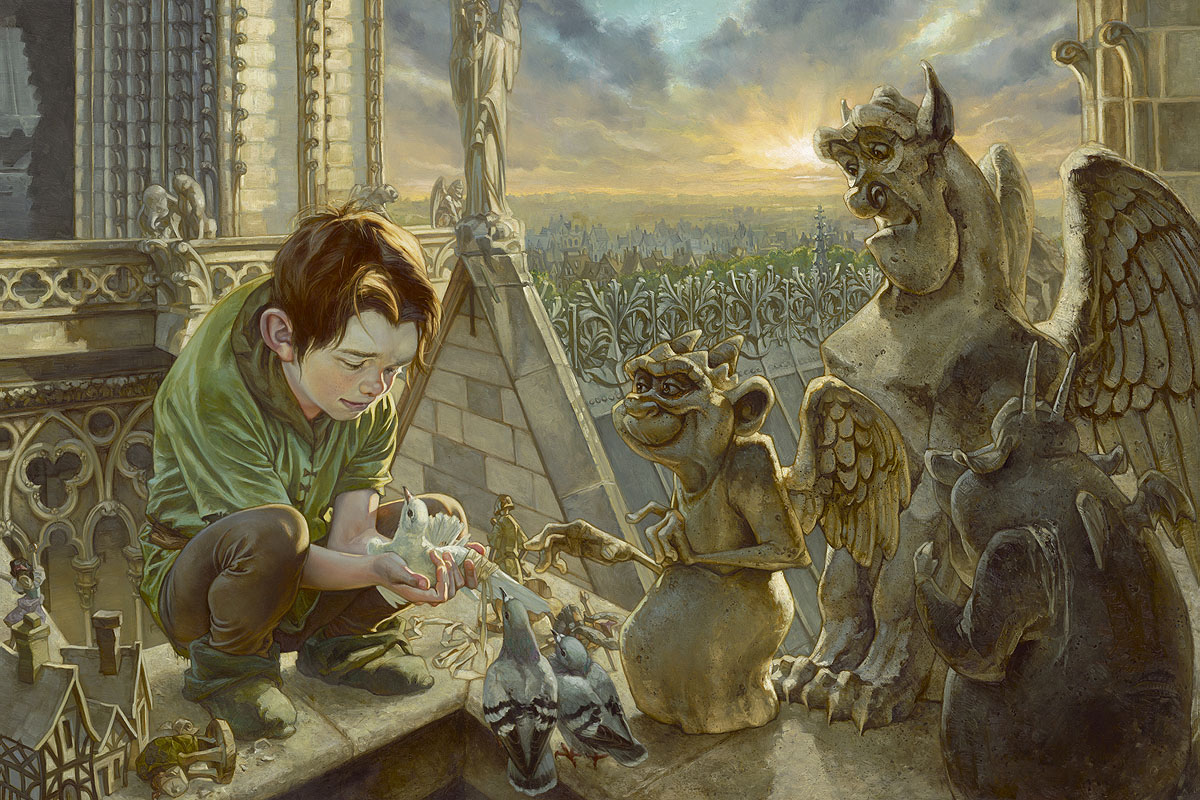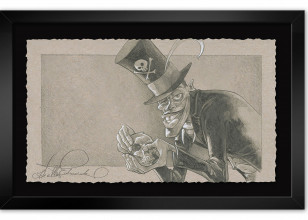Product Description
God Help the Outcasts, featuring Quasimodo of The Hunchback of Notre Dame, is realistically portrayed. Here he is a young boy, in this pivotal part of Victor Hugo's story centering one of Paris's most beautiful landmarks, in "God Help the Outcasts"
God Help the Outcasts comes with a certificate of authenticity.
About God Help the Outcasts, in the words of Heather Edwards:
|
It was a cool November afternoon on a train ride through Paris from Versailles to Disneyland Paris. My husband sat across from me with his eyes closed to rest and my son was next to me, earphones on and glued to his cell phone in an attempt to block out the rest of the world. We’d spent the last few days walking the streets of one of the most enchanting cities on earth, visiting museums, sampling the delectable food and being awestruck by monumental landmarks. I let my gaze wander out the window. Centuries of history rolled by as I sat there and as I recalled the previous few days’ adventures, I couldn’t help but contemplate the struggles, the triumphs and the day-to-day humdrum tasks belonging to the people of this city over the years–which may have presented themselves in different forms, but at their core hadn’t changed in a millennia. Neither were those struggles and triumphs and tasks unique to one group of people. We all experience them in one way or another and, in addition to creating mighty tides that move us within our own sphere of existence, they shape our perceptions of ourselves, others and the world around us. In the very midst of these thoughts, I saw an image so clear and defined in my mind’s eye so as to cause me to take in a startled breath, for with it came a full understanding of what it meant and why it was that I needed to see it. I knew that I needed to paint what I had seen. Admittedly, I fought to keep my tears hidden during all of this, it was that personally powerful. The image was of a young Quasimodo, cradling an injured dove in his hands with his beloved cathedral rooftop companions looking on. But there was more to the scene than what may initially be taken in. The entire story unfolding within it revolves around perceptions–and how we allow them, or not allow them, to direct our actions. Contemplating the characters within the image, it doesn’t take much to see that most, if not all, of them could be considered a rather motley group. “Grotesque” is even a common term used to describe Quasimodo’s three best friends, the chimeras Victor, Hugo and Laverne; and Notre Dame Cathedral, the setting of the image, in all her glory is overrun by their scary stone counterparts. A pair of pigeons, regularly referred to as “rats with wings” join them on the balcony and Quasimodo himself faces a world that views him as a monster and unwelcome. The only character that would be candidly represented as “beautiful” would be the dove. Being introspective, one might ask, where do I find myself in this picture? Do I see myself similar to the pigeons; despised and not nearly as attractive or appealing as their cousin, the white dove? Am I like Victor and the others who are “unseen” as if they do not exist except to a charitable few and feeling constrained by their invention? Conversely, could it be said of me that, like the other unmoving stone figures, I stand by stoic and unwilling to lend a hand? Or perhaps do I see myself more like the dove, perceived by others to “have it all”, in beauty or charm or symbolic ideal, nonetheless suffering from the knowledge that just like everyone else, there’s a part of me that is broken as well. If akin to Quasimodo, will I see myself as inadequate and unloved, even incapable of rendering compassion, displayed so evidently in the unrefined carved version he has created of himself? Likewise, how do I perceive others in this picture? Do I envy those who I feel are more revered than I? Do I look down upon those who appear, act or believe differently than I do? Am I willing to accept gentle benevolence, even when I know from whom it comes is younger, less experienced or struggles more than I? Taking another, closer look at the image, one can see that none of these beautiful souls is allowing their perceptions, whether real or imagined, to hold them back from kindness. They gather around each other, ready to help. I have come to the realization that we all can do the same. It need not be for any other reason than we understand that we are all a bit broken and we all need a little love and nurturing; every one of us is an outcast. ~Heather Edwards |
About Heather Theurer (Heather Edwards):
Some stories begin on well-defined roads or with billboard accomplishments. But the story of an artist usually begins somewhere less noticeable, perhaps even unrecognizable to most. It is just such a beginning that gave life to the art of creator, Heather Theurer. Paintings were born from 5:45 a.m. mornings during summer breaks from school in Paradise, Utah, waking up to breathe in the crisp air and watch the sun rise and glow through the blades of grass in the lawn. Ideas sprung from thunderstorms, the struggles of working on a small farm and from the loyal companionship of pets. Personal experiences combined to shape the narrative behind each forthcoming creation.
From that vantage point, life itself became the paint on the brush and the guiding force behind everything Heather made and from as early as her pre school years she knew that making art was what she wanted to do for the rest of her life. However, receiving extra training or attending an acknowledged art school were not to be part of her story. Yet, it was from her own father that she learned one of her most valuable lessons: observe. It was a simple enough concept, but it stuck.
Heather's paintings are the product of decades of observation of people, of environments, of animals and of textiles, as well as the convergence of every scrap of knowledge that came attached to them. The wonder and magic of Disney movies, both the imagery and the music, also helped cultivate the ideas that began to take form in painting, and now, boldly recreating Disney characters in a way that brings them into the realism of our world has become an exciting new passion.
Shared and collected around the world, Heather Theurer's paintings are constructed in the midst of a bustling family with five children in Las Vegas, Nevada. And although that poses a multitude of challenges of its own, her art has gone on to get the attention of USA Today, the LA Times and received recognition and awards from respected organizations such as Art Renewal Center, Artist's Magazine and Spectrum, among others.
To Heather, every painting is personal, but not necessarily in the way most might think. "I don't necessarily want the viewer to have the same response to my painting as I have. Instead, my hope is that the expression I paint on the board through hours of observation and execution of detail will speak to them in a way that ignites thoughts and feelings unique to them."





